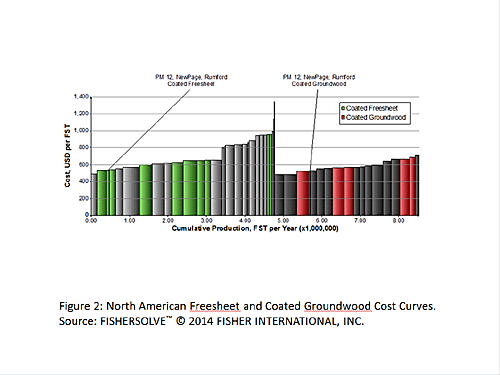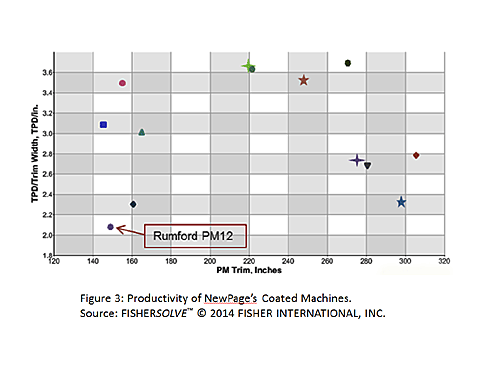 |
||||||||
| December 4, 2013 | ||||||||
| DryOnyx is ideal for on-site coating |  |
|||||||
| · www.tappi.org · Subscribe to Ahead of the Curve · Newsletters · Ahead of the Curve archived issues · Contact the Editor |
Why did NewPage choose to shut down Rumford PM12? By Tedd Powers Within a few hours of NewPage’s, announcement [November 19, 2013] that they planned to shut down PM12 at their Rumford, Maine, facility, my phone began to ring with questions about the decision. No one should doubt that coated paper producers in North America need to reduce capacity in light of persistently declining demand. But much like IP’s decision to close their Courtland facility, this announcement begs a couple of interesting questions: Why NewPage? And if NewPage, why PM 12 at Rumford? Figure 1 shows the combined markets for coated freesheet and coated groundwood grades in North America and demonstrates NewPage’s ability and incentive to balance supply and demand. The company has, by far, the most capacity and therefore the most excess capacity. While removing the tons on PM 12 at Rumford will not significantly alter the supply/demand balance, it does show that NewPage is willing to exercise leadership by making tough decisions. Of course, they also have the most to gain by working toward improved market dynamics. So, as tons need to come out of the system, it is completely logical that NewPage lead the way. But why select PM 12 at Rumford for closure? One of those phone calls I mentioned was from someone looking at a cost curve and wondering why that machine was chosen. The cost curve shown in Figure 2, splits coated freesheet and coated groundwood grades to show that PM 12 at Rumford is a low cost producer of each; the green and red bars represent all of NewPage’s machines making these grades. So why not close one of the many other, higher cost machines first? The answer is that today’s cost is only one element to consider when evaluating a machine or mill’s long term competitive position. In addition to cost, it is necessary to evaluate the productivity of a machine to understand both its efficiency and effectiveness. Cost and productivity are often thought of as synonymous, but this is not always true. A machine producing a lot of tons per day may be efficient, but if all of those tons are produced at a high cost it is certainly not very effective. Conversely, a machine could be low cost but inefficient in terms of production, and therefore just as ineffective. The graph in Figure 3 plots the tons per-day-per-inch of trim, against the total trim for each NewPage coated machine. We can compare the tons per day of similarly sized machines to find which are most productive. PM 12 at Rumford stands out as one of the smallest and the least productive machines in the fleet—-usually not a winning combination for a machine making commodity grades. But perhaps the best way to evaluate the long-term competitiveness of a machine is to consider several factors all at once. FisherSolve’s Benchmark Viability module evaluates assets with a broad basket of metrics including cost competitiveness, capital requirements, asset quality, scale, grade health, and several other factors. A higher Viability Index score indicates greater risk. The viability curve in Figure 4, comparing only NewPage coated machines—-they cannot close anyone’s machines but their own—-clearly demonstrates that PM 12 at Rumford is the highest risk machine in their fleet and the logical choice for closure. There are times when the decisions of others are not clear to observers who stand on the outside looking in, and sometimes those decisions aren’t even clear to those on the inside. However, it is possible to better understand and perhaps even anticipate these decisions if we ask the right questions. In the pulp and paper industry, the cost of manufacture is certainly an important measure but it is simply not sufficient to focus only on that single metric. Digging below the surface yields the richest finds and thorough analysis results in the most profitable decisions. Tedd Powers is a Senior Consultant at Fisher International, Inc. He can be contacted at tpowers@fisheri.com. The source for market data and analyses in this article is FisherSolve. To learn more, please visit www.fisheri.com.
Now that you
are Ahead of the Curve, stay there by joining TAPPI. |
|||||||
 |
||||||||







